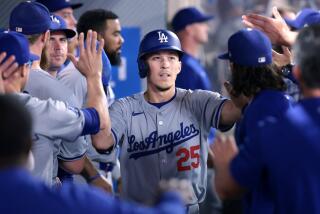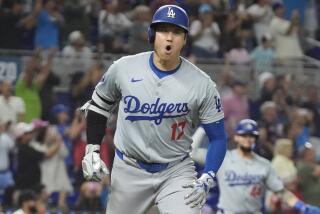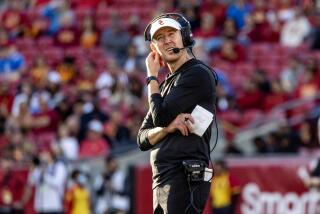2,989, but Who Counts? : Not the Indians’ Eddie Murray, Who Talks Softly While Still Swinging a Big Stick After 19 Years
CLEVELAND — He is about to become the 19th player with 3,000 hits. A year from now he might become the 15th with 500 home runs.
At 39, a long way from the Los Angeles sandlots where he learned to hit a curveball by trying to time the unpredictable movements of Crisco can lids thrown by one of his four brothers, Eddie Murray continues to pile up credentials that should make him an automatic selection for the Hall of Fame, providing the voting writers overlook his seldom talking to them.
Even now, only 11 hits shy of 3,000, the Cleveland Indians’ first baseman and designated hitter has rejected most recent interview requests.
He will help rebuild baseball’s bridges with his bat, not his words.
“It’s really sad that he’s reaching this plateau and there’s still so much negative being written about an outstanding person and player who’s been so good for the game,” said Baltimore Oriole coach Elrod Hendricks, a former teammate and longtime friend.
Sad, indeed, that Murray’s almost pathological distrust of sportswriters--he generally makes an exception for reporters covering the Indians--now spans almost two decades and tends to cloud stories of his accomplishments and the respect of his teammates.
“Eddie is fantastic, one of the best teammates I’ve ever played with, a true professional,” said Orel Hershiser, a teammate with the Dodgers and now the Indians. “From what I know and what I’ve seen, he has the pulse of every club he’s been on. He’s a day-to-day force who knows how to pick his spots and put people in their place--generally with humor, not an iron fist.”
In this summer that Cal Ripken Jr. seems destined to break Lou Gehrig’s record for consecutive games, the Oriole shortstop said he still misses having Murray “to lean on” when he’s struggling. They were teammates with the Orioles from 1981-88.
“Even before the streak was born, it was Eddie who influenced my approach to the game and taught me the importance of being there every day for the team,” Ripken said.
“He took me under his wing and taught me how playing every day gave stability to the lineup, dependability to the defense.”
After 12 years with the Orioles, three with the Dodgers and two with the New York Mets, Murray was signed by the Indians as a free agent before the 1994 season to provide protection for cleanup hitter Albert Belle and leadership in the clubhouse. He has done both, the Indians say, resolutely avoiding attention.
Murray had Hendricks and some other Orioles for dinner at his Cleveland home after a recent game. The subject of 3,000 hits never came up, Hendricks said, adding, “Bring up numbers and he’ll change the subject.”
That’s his style--consistent, low-key, professional.
“As happy as we all are for Eddie, I’m sure he regards [3,000 hits] only as part of his job,” oldest brother Charles Murray said. “I wouldn’t say he’s excited. He takes things in stride. He’s always tried to approach the game on an even keel.”
When he became the first position player to receive a $1-million salary in 1979, he bought a gold necklace that said, “Just Regular.”
The Orioles retired his No. 33 in 1989 and Murray’s only comment was, “No comment.” The Indians played it smart, telling Murray they were hanging a 3,000 countdown banner at Jacobs Field and planning a night in honor of the accomplishment without asking his permission.
This is a guy who makes unscheduled stops at Little League fields to talk with youngsters, who is known as “Uncle Eddie” to dozens of his current and former teammates’ kids, who has been nominated several times for the Roberto Clemente award for his charity involvement but who has jumped on his agent, Ron Shapiro, for releasing lists documenting that involvement.
Said Indian General Manager John Hart, a former coach and minor league manager with the Orioles, “I think much of the way Eddie is stems from the fact that he came up to the Orioles at a time when they had a group of throwback guys, like Lee May and Ken Singleton and Jim Palmer.
“Who they were and what they did rubbed off on how Eddie approached the game, but he didn’t have to be the focal point, and I think that’s how Eddie is most comfortable and why he’s so comfortable here.”
When those throwback guys began to leave and the Orioles began to falter, expectations on Murray reached a level he couldn’t deal with and he ultimately asked to be traded, amid deepening distrust of the media.
It is a distrust born of a column by the late Dick Young in the New York Daily News during the 1979 World Series. Young alleged that an Oriole scout trying to sign Murray several years earlier had been treated rudely by the Murray family, an account hotly disputed by family friends.
The distrust deepened when media and fans in Baltimore seemed to feed off comments by a frustrated Edward Bennett Williams, the late Oriole owner, who accused Murray of “doing nothing” in 1986, when the former powerhouse in the American League East finished last and Murray, who had hit 31 homers and driven in 124 runs the year before, fell to 17 and 84.
It was a year in which Murray grieved over the deaths of his mother and sister and missed 25 games while on the disabled list for the only time in his career.
When traded to the Dodgers in December of 1988, “It was the best thing that could have happened,” Shapiro said. “He was worn out by the battle with Williams, the media and a vocal minority of fans who at times seemed to turn it into a racial thing. The game again became fun for Eddie in L.A., but it was kind of sad. By all rights, Eddie should have finished his career in Baltimore and gone right to the Hall of Fame.”
In a recent interview with the Akron Beacon Journal, Murray said he was hesitant to put his relations with the media in the context of race.
“But, sometimes, there seems to be a difference in reporting between white and black players,” he said. “It happens too often for it just to be [an accident]. But . . . I’ve had no problems here in Cleveland. They just let me play ball.”
Murray had no problems in Los Angeles, either. The Dodgers ultimately had to make room for Eric Karros, and Murray left as a free agent after the 1991 season and three solid years, highlighted by his .330 average, 26 homers and 95 RBI in 1990.
“He was outstanding in every way--presence, performance and professionalism,” said Fred Claire, Dodger executive vice president. “People may not realize this about Eddie, but I don’t know of anyone who is more a student of the game or enjoys the strategy more. I think he has an outstanding future in player development.”
Shapiro suspects that Murray’s immediate future includes two or three more years as a player.
Murray drove in 76 runs and hit 17 homers in 108 games last year, staying in the lineup despite a severely strained thumb, and this year he has a .311 average, nine homers--for a total of 467--and 36 RBIs in 47 games.
Frank Robinson, the Orioles’ assistant general manager and a coach and manager during several of Murray’s Baltimore seasons, said three things have contributed most to Murray’s success: His switch-hitting productivity, his concentration with runners on base and his willingness to remember and adjust to pitchers strengths, the count and the game situation.
Remarkably, Murray has never led his league in any offensive category over a full season, but he could soon join Hank Aaron and Willie Mays as the only players to achieve both 3,000 hits and 500 home runs. Murray is 14th on the list in RBIs, 13th in total bases and 18th in games played--the leader at first base.
If he drives in 75 or more runs this year--he has never driven in fewer than 84 in a full season--he will tie Aaron’s record streak of 19 consecutive seasons with 75 or more.
“I don’t put numbers in my head. I just try to keep going,” Murray told a group of Cleveland area writers recently. “The challenge is to improve every year. My consistency is something I’m most proud of because that’s what the game is all about--going out every day and trying to produce.”
That and doing it right.
“Some of today’s young players will take the challenge when you talk to them, and some will lay down on you,” Murray said in the Akron interview. “But you can’t let little things go by. You can’t have guys missing the cut-off man and throwing the ball anywhere. You can’t have guys not paying attention. If I see that, I’ll speak up. It’s up to the guy if he wants to listen or not.”
Murray has always done more listening than talking. He played on the same team with Ozzie Smith at Locke High, and much of his approach was shaped during those early years in South Central when he competed with four older brothers, all of whom played professionally, and fed off the legacy of older pros who would return to that onetime hotbed for sandlot games and workouts. Reggie Smith, Willie Crawford, Davey Nelson, Bobby Tolan, Doc Ellis, Lonnie Smith and Don Wilson were among them.
Now, as his friend follows the road map to Cooperstown, Elrod Hendricks said, “Eddie is having his fun doing what he enjoys doing--playing ball and winning. He may not show emotion one way or another, but I know he’s excited.
“I don’t care who you are, you’ve got to be excited getting that many hits. Most guys don’t get that many at-bats.”
(BEGIN TEXT OF INFOBOX / INFOGRAPHIC)
MIRROR IMAGE
There are no eligible players with similar lifetime statistics to Murray’s who have not made the Hall of Fame. The closest parallel to Murray is his teammate, Dave Winfield. The two players who come closest:
Player Hits HR RBI Avg Slg% Murray 2,989 467 1,774 .288 .481 Winfield 3,098 464 1,832 .283 .475 Yaz 3,419 452 1,844 .285 .462
HOW HE RATES
There are 15 first basemen in the Hall of Fame: Cap Anson, Jake Beckley, Jim Bottomley, Dan Brouthers, Frank Chance, Roger Connor, Jimmie Foxx, Lou Gehrig, Hank Greenberg, George Kelly, Harmon Killebrew, Willie McCovey, Johnny Mize, George Sisler and Bill Terry. How Murray ranks statistically with them:
Category Number Pos. Comment Hits 2,989 2nd Six hits behind Cap Anson Home Runs 467 5th Trails Killebrew, Foxx, McCovey and Gehrig RBIs 1,774 4th Trails Gehrig, Foxx and Anson Batting Avg. .288 14th Ahead of McCovey and Killebrew
More to Read
Go beyond the scoreboard
Get the latest on L.A.'s teams in the daily Sports Report newsletter.
You may occasionally receive promotional content from the Los Angeles Times.










